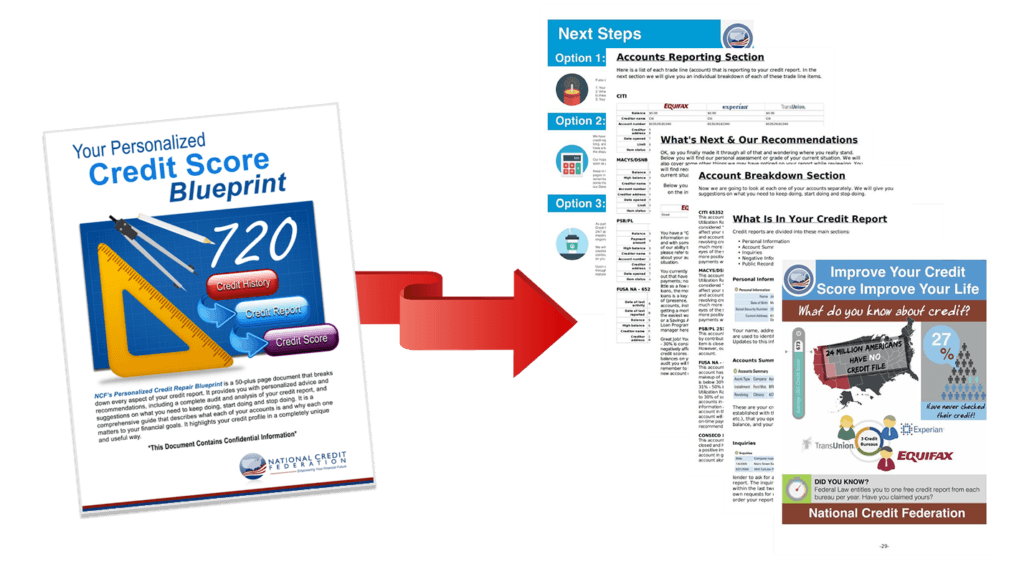Learn About Credit 101: Lesson 3 of 4
What does My Credit Score Mean?
Before credit scoring was introduced into the lending industry, the credit gaining process was inconsistent and slow. Your credit score is a snap shot of your current financial situation that helps creditors make a quick, unbiased measure of the risk of lending to you. Since the addition of credit scores people can get loans faster, credit decisions are fairer, “mistakes” count for less, more credit is available, and credit rates are lower.
Credit scoring is a benefit to borrowers who take pride in protecting and managing their score. Now we all know that things happen and sometimes it doesn’t matter how prepared you think you are, times just get rough. Our goal here at National Credit Federation is to help you get your financial status back on track. In fact we’ve put together the best tips on how to improve credit score profiles.
These mistakes and low scores don’t happen overnight so it does take time, but our average member sees a 127 point increase on their score by the 6 month mark. Imagine what that kind of score increase could do for you!
Under 500
The lowest category – It’s usually a sign of bankruptcies, foreclosure, collections, charge-offs, etc. It’s very difficult, if not impossible, to obtain credit. If you are able to find credit, it will require you to put up large portions in cash or equity. If you accept the offer, it will force you into paying ridiculous interest rates as well.
500-599
Bad credit – Typically due to late payments, charge offs, medical collections, etc… If you get financing, you are then required to pay large closing costs. You will also be charged very high interest rates due to the risk the lender undertakes in lending you money.
600-649
Fair credit – You will find unfavorable terms in financing, but there are more sources made available to you than the previous category.
650-700
Good score – However, with today’s tighter lending standards, there are less products available to meet the unique needs of borrower. You may be forced into agreeing to terms that you would otherwise not consider.
700-719
Great credit – Lenders want to loan you money. You are a good credit risk and will receive favorable financing terms. However with today’s tighter lending standards, you may not have low documentation type loans available to you without proving a substantial amount of equity in the transaction.
720 or higher
Excellent credit – This is the category where opportunities arise with any type of financing that may be available. This should be the goal of every consumer. At National Credit Federation, we will teach you how to not only obtain, but maintain this excellent score. It may take some time and discipline, but everyone can eventually achieve this score if equipped with the proper knowledge.
The average difference in scores between the highest and lowest of your three FICO scores from the three major bureaus is 60 points. This is the result of each of the credit bureaus having different items on their report, which may be correct, incorrect or are not reported in full compliance with credit law.
According to the Government Accountability Office, 80-90% of credit reports have serious errors on them and this does not even include the more minute errors. NCF’s program is 100% legal. We aren’t disputing the fact that these negative events took place. We just work to make sure that all the information associated with the account is 100% accurate.
If you’d like a detailed analysis of your credit profile we encourage you to checkout out our Credit Blueprint. It’s a 50+page personalized audit of your credit profile. It explains the good, the bad, the ugly and what to do differently to improve your profile to become “an attractive lending risk.”
Lending risk is what all lenders (mortgages, auto, insurance, credit card companies etc) take into account when determining the dollar amount and rate at which they are willing to lend borrowers.
This is the very first steo we use in our business for our own clients.
This is where we sift, sort, and filter all the information on a credit report that a lender would look at, and determine exactly what needs to happen to put the borrower in a better financial situation.
It breaks down not only the trade lines, but the validity of the tradelines, what they mean, and how they are affecting a FICO score AND the credit profile over all.
Here’s an example:


